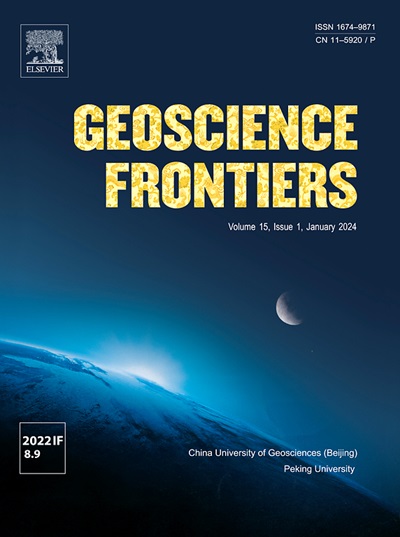Preservation potential of Cambrian small shelly fossils in different microfacies, North China
IF 8.9
1区 地球科学
Q1 GEOSCIENCES, MULTIDISCIPLINARY
引用次数: 0
Abstract
Small shelly fossils (SSFs) have long been recognized as important to the studies of both metazoan evolution and the onset of biomineralization during the Cambrian radiation. The marked decline in the occurrence, diversity and abundance of SSFs in the middle to late Cambrian, when compared with the early Cambrian, has often been regarded as a result of the closure of a phosphatization window. Despite this, there have been numerous and consistent reports of SSFs from the middle Cambrian and younger deposits. To identify possible factors influencing SSF preservation, five microfacies including bioclastic limestone, flat-pebble conglomerates with bioclasts, hummocky cross-stratified grainstone with bioclasts, bioclastic grainstone in hardgrounds and glauconite bioclastic wackstone-packstone, from Cambrian Series 2 to Miaolingian in North China are compared to assess how differences in lithology impact the preservation potential of SSFs. Our results, based on 35,161 SSF specimens from deposits across six sections, suggest that there are still abundant and diverse SSFs in the middle Cambrian of North China preserved in ways not exclusively reliant on the presence of phosphate and that SSF preservation can be linked to the differences in microfacies in the early to middle Cambrian of North China.

华北不同微相寒武系小壳类化石的保存潜力
小壳类化石在寒武纪辐射期间的后生动物进化和生物矿化开始的研究中一直被认为是重要的。与早寒武世相比,中晚寒武世ssf的出现、多样性和丰度显著下降,通常被认为是磷化窗口关闭的结果。尽管如此,在中寒武纪和更年轻的矿床中已经有大量一致的ssf报告。为了确定影响SSF保存的可能因素,对华北地区寒武系二系至妙岭系的生物碎屑灰岩、含生物碎屑的平卵石砾岩、含生物碎屑的丘状交叉层状颗粒岩、硬地层生物碎屑颗粒岩和海绿石生物碎屑碎屑灰岩等5种微相进行了比较,探讨了岩性差异对SSF保存潜力的影响。研究结果表明,华北中寒武统中仍存在丰富多样的SSF,其保存方式并非完全依赖于磷酸盐的存在,而且SSF的保存可能与华北早、中寒武统微相的差异有关。
本文章由计算机程序翻译,如有差异,请以英文原文为准。
求助全文
约1分钟内获得全文
求助全文
来源期刊

Geoscience frontiers
Earth and Planetary Sciences-General Earth and Planetary Sciences
CiteScore
17.80
自引率
3.40%
发文量
147
审稿时长
35 days
期刊介绍:
Geoscience Frontiers (GSF) is the Journal of China University of Geosciences (Beijing) and Peking University. It publishes peer-reviewed research articles and reviews in interdisciplinary fields of Earth and Planetary Sciences. GSF covers various research areas including petrology and geochemistry, lithospheric architecture and mantle dynamics, global tectonics, economic geology and fuel exploration, geophysics, stratigraphy and paleontology, environmental and engineering geology, astrogeology, and the nexus of resources-energy-emissions-climate under Sustainable Development Goals. The journal aims to bridge innovative, provocative, and challenging concepts and models in these fields, providing insights on correlations and evolution.
 求助内容:
求助内容: 应助结果提醒方式:
应助结果提醒方式:


